| National Flag |
|
The National flag is a horizontal tricolour of deep saffron (kesari) at the top, white in the middle and dark green at the bottom in equal proportion. The ratio of width of the flag to its length is two to three. In the centre of the white band is a navy blue wheel which represents the chakra. Its design is that of the wheel which appears of the abacus of the Sarnath Lion Capital of Ashoka. Its diameter approximates to the width of the white band and it has 24 spokes.
|
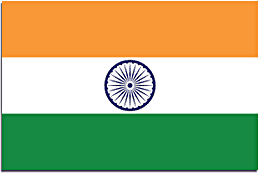
|
The design of the national flag was adopted by the Constituent Assembly of India on 22 July 1947. Its use and display are regulated by the Indian Flag Code.
|
|
| State Emblem |
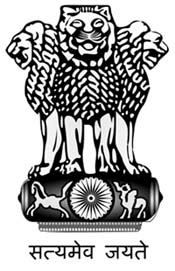
|
The state emblem is an adaptation from the Sarnath Lion Capital of Ashoka. In the original, there are four lions, standing back to back, mounted on an abacus with a frieze carrying sculptures in high relief of an elephant, a galloping horse, a bull and a lion separated by intervening wheels over a bell-shaped lotus. Carved out of a single block of polished sandstone, the capital is crowned by the wheel of the Law (Dharma Chakra).
In the State emblem, adopted by the Government of India on 26 January 1950,only three lions are visible, the fourth being hidden from view. The wheel appears in relief in the centre of the abacus with a bull on right and left. The bell-shaped lotus has been omitted. The words Satyameva Jayate from Mundaka Upanishad, meaning `Truth Alone Triumphs', are inscribed below the abacus in Devanagari script.
|
|
| National Anthem |
|
The song Jana-gana-mana, composed originally in Bengali by Rabindranath Tagore, was adopted in its Hindi version by the Constituent Assembly as the national anthem of India on 24 January 1950.It was first sung on 27 December 1911at the Calcutta Session of the Indian National Congress. The complete song consists of five stanzas. The first stanza contains the full version of the National Anthem :
Jana-gana-mana-adhinayaka, jaye he
Bharata-bhagya-vidhata.
Punjab-Sindh-Gujarat-Maratha
Dravida-Utkala-Banga
Vindhya-Himachala-Yamuna-Ganga
Uchchala-Jaladhi-taranga
Tava shubha name jage,
Tava shubha asisa mage,
Gahe tava jaya gatha,
Jana-gana-mangala-dayaka jaya he
Bharata-bhagya-vidhata.
Jaya he, jaya he, jaya he,
Jaya jaya jaya jaya he!
Playing time of the full version of the national anthem is approximately 52 seconds. A short version consisting of first and last lines of the stanza (playing time approximately 20 seconds) is also played on certain occasions. The following is Tagore's English rendering of the anthem :
Thou art the ruler of the minds of all people,
dispenser of India's destiny.
Thy name rouses the hearts of Punjab, Sind,
Gujarat and Maratha
Of the Dravida and Orissa and Bengal;
It echoes in the hills of the Vindhyas and Himalayas,
mingles in the music of Jamuna and Ganga and is
chanted by the waves of the Indian Sea.
They pray for thy blessings and sing thy praise.
The saving of all people waits in thy hand,
thou dispenser of India's destiny.
Victory, victory, victory to thee.
|
| National Song |
|
The song Vande Mataram, composed in Sanskrit by Bamkimchandra Chatterji, was a source of inspiration to the people in their struggle for freedom. It has an equal status with Jana-gana-mana. The first political occasion when it was sung was the 1896 session of the Indian National Congress. The following is the text of its first stanza:
Vande Mataram!
Sujalam, suphalam, malayaja shitalam,
Shasyashyamalam, Mataram!
Shubhrajyothsna pulakitayaminim,
Phullakusumita drumadala shobhinim,
Suhasinim sumadhura bhashinim,
Sukhadam varadam, Mataram!
The English translation of the stanza rendered by Sri Aurobindo in prose is:
I bow to thee, Mother,
richly-watered, richly-fruited,
cool with the winds of the south,
dark with the crops of the harvests,
The Mother!
Her nights rejoicing in the glory of the moonlight,
her lands clothed beautifully with her trees in flowering bloom,
sweet of laughter, sweet of speech,
The Mother, giver of boons, giver of bliss.
|
| National Calendar |
|
The national calendar based on the Saka Era with Chaitra as its first month and a normal year of 365 days was adopted from 22 March 1957 along with the Gregorian calendar.
Dates of the national calendar have a permanent correspondence with dates of the Gregorian calendar : 1 Chaitra falling on 22 March normally and on 21 March in leap year.
|
| National Animal |
|
The magnificent tiger, Panthera tigers (Linnaeus), is a striped animal. It has a thick yellow coat of fur with dark stripes. The combination of grace, strength, agility and enormous power has earned the tiger its pride of place as the national animal of India. Out of eight races of the species known, the India race, the Royal Bengal Tiger, is found throughout the country except in the north-western region and also in the nighbouring countries, Nepal, Bhutan and Bangladesh. To check the dwindling population of tigers in India `Project Tiger' was launched in April 1973. So far, 25 tiger reserves have been established in the country under this project, covering an area of 33,875 sq km.
|
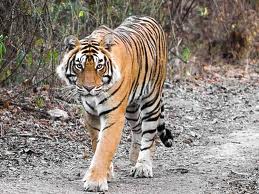
|
|
| National Bird |
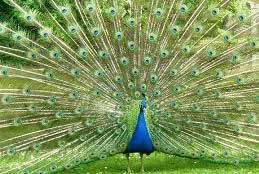
|
The Indian peacock, Pavo cristatus (Linnaeus), the national bird of India, is a colourful, swan-sized bird, with a fan-shaped crest of feathers, a white patch under the eye and a long, slender neck. The male of species is more colourful than the female, with a glistening blue breast and neck and a spectacular bronze-green train of around 200 elongated feathers. The female is brownish, slightly smaller than the male, and lacks the train. The elaborate courtship dance of the male, fanning out the tail preening its feathers, is a gorgeous sight.
|
|
The peacock is widely found in the India sub-continent from the south and east of the Indus river, Jammu and Kashmir, east Assam, south Mizoram and the whole of the Indian peninsula. The Peacock enjoys protection from the people as it is never molested for religious and sentimental reasons. It is fully protected under the Indian Wildlife (Protection) Act, 1972.
|
|
| National Aquatic Animal |
|
River Dolphin is the National Aquatic Animal of India. This mammal is also said to represent the purity of the holy Ganga as it can only survive in pure and fresh water. Platanista gangetica has a long pointed snout and also have visible teeth in both the upper and lower jaws. Their eyes lack a lens and therefore function solely as a means of detecting the direction of light. Dolphins tend to swim with one fin trailing along the substrate while rooting around with their beak to catch shrimp and fish. Dolphins have a fairly thick body with light grey-brown skin often with a hue of pink. The fins are large and the dorsal fin is triangular and undeveloped. This mammal has a forehead that rises steeply and has very small eyes. River Dolphins are solitary creatures and females tend to be larger than males. They are locally known as susu, because of the noise it makes while breathing. This species inhabits parts of the Ganges, Meghna and Brahmaputra rivers.
|
|
River dolphin is a critically endangered species in India and therefore, has been included in the Schedule I for the Wildlife (Protection) Act, 1972. The main reasons for decline in population of the species are poaching and habitat degradation due to declining flow, heavy siltation, construction of barrages causing physical barrier for this migratory species.
|
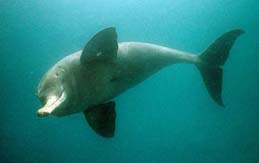
|
|
| National Flower |
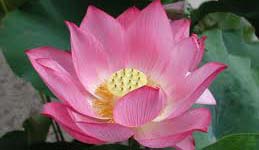
|
Lotus (Nelumbo nucifera) is the National Flower of India. It is a sacred flower and occupies a unique position in the art and mythology of ancient India and has been an auspicious symbol of Indian culture since time immemorial.
|
|
| National Tree |
|
Indian fig tree, Ficus bengalensis, whose branches root themselves like new trees over a large area. The roots then give rise to more trunks and branches. Because of this characteristic and its longevity, this tree is considered immortal and is an integral part of the myths and legends of India. Even today, the banyan tree is the focal point of village life and the village council meets under the shade of this tree.
|
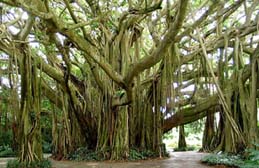
|
|
| National River |
|
The Ganga or Ganges is the longest river of India flowing over 2,510 kms of mountains, valleys and plains. It originates in the snowfields of the Gangotri Glacier in the Himalayas as the Bhagirathi River. It is later joined by other rivers such as the Alaknanda, Yamuna, Son, Gumti, Kosi and Ghagra. The Ganga river basin (External website that opens in a new window) is one of the most fertile and densely populated areas of the world and covers an area of 1,000,000 sq. kms. There are two dams on the river - one at Haridwar and the other at Farakka. The Ganges River Dolphin is an endangered animal that specifically habitats this river.
|
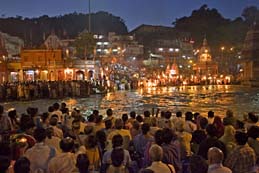
|
The Ganga is revered by Hindus as the most sacred river on earth. Key religious ceremonies are held on the banks of the river at cities such as Varanasi, Haridwar and Allahabad. The Ganga widens out into the Ganges Delta in the Sunderbans swamp of Bangladesh, before it ends its journey by emptying into the Bay of Bengal.
|
|
| National Fruit |
|
A fleshy fruit, eaten ripe or used green for pickles etc., of the tree Mangifera indica, the mango is one of the most important and widely cultivated fruits of the tropical world. Its juicy fruit is a rich source of Vitamins A, C and D. In India there are over 100 varieties of mangoes, in different sizes, shapes and colours. Mangoes have been cultivated in India from time immemorial. The poet Kalidasa sang its praises. Alexander savoured its taste, as did the Chinese pilgrim Hieun Tsang. Mughal emperor Akbar planted 100,000 mango trees in Darbhanga, Bihar at a place now known as Lakhi Bagh.
|
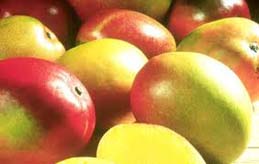
|
|
| National Game |

|
India has conquered the podium when it comes to the game of Hockey. India has an excellent record with eight Olympic gold medals. Indian hockey's golden period was from 1928-56, when the Indian hockey team won six successive Olympic gold medals. Team also won the 1975 World Cup besides two more medals (silver and a bronze).
|
During the Golden Era, India played 24 Olympic matches, won all 24, scored 178 goals (at an average of 7.43 goals per match) and conceded only 7 goals. The two other gold medals for India came in the 1964 Tokyo Olympics and the 1980 Moscow Olympics.
|
|
| Currency Symbol |
The symbol of Indian Rupee typifies India's international identity for money transactions and economic strength. The Indian Rupee sign is an allegory of Indian ethos. The symbol is an amalgam of Devanagari "Ra" and the Roman Capital "R" with two parallel horizontal stripes running at the top representing the national flag and also the "equal to" sign. The Indian Rupee sign was adopted by the Government of India on 15th July, 2010.
The symbol, conceptualised and designed by Udaya Kumar, a post graduate in Design from Indian Institute of Technology Bombay, has been chosen from thousands of concept entries received by the Ministry of Finance through an open competition among resident Indian nationals.
|

|
|
|
| Famous Quotes on India |
|
India is the cradle of the human race, the birthplace of human speech, the mother of history, the grandmother of legend, and the great grand mother of tradition. Our most valuable and most artistic materials in the history of man are treasured up in India only!
|
|
Mark Twain
|
|
Read more quotes
|
|
|
